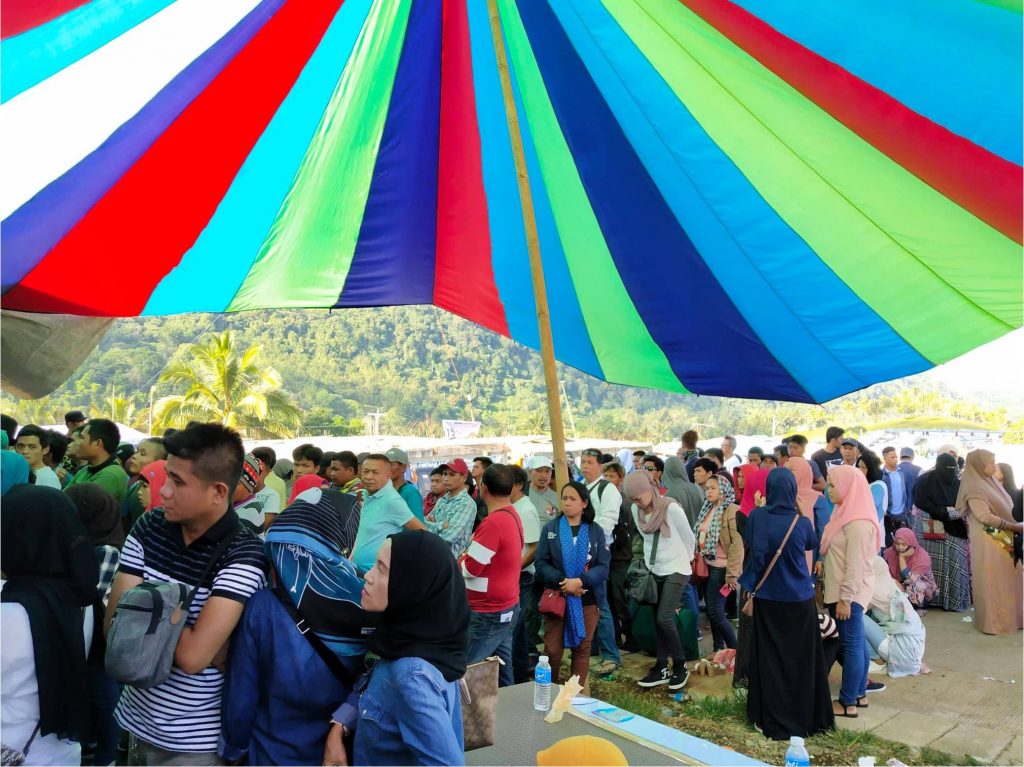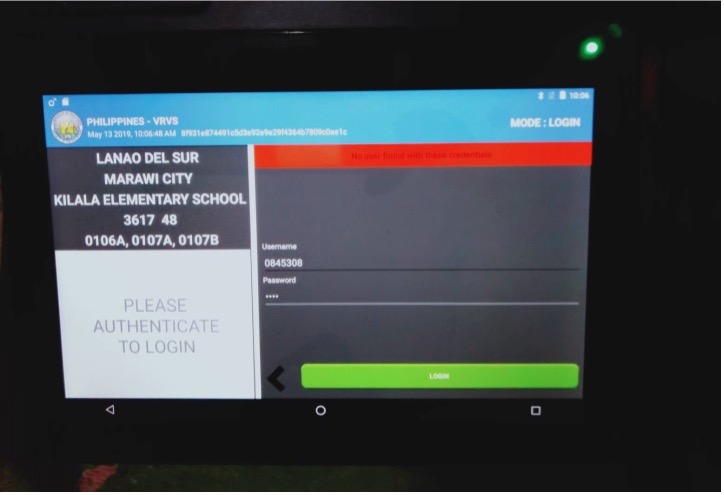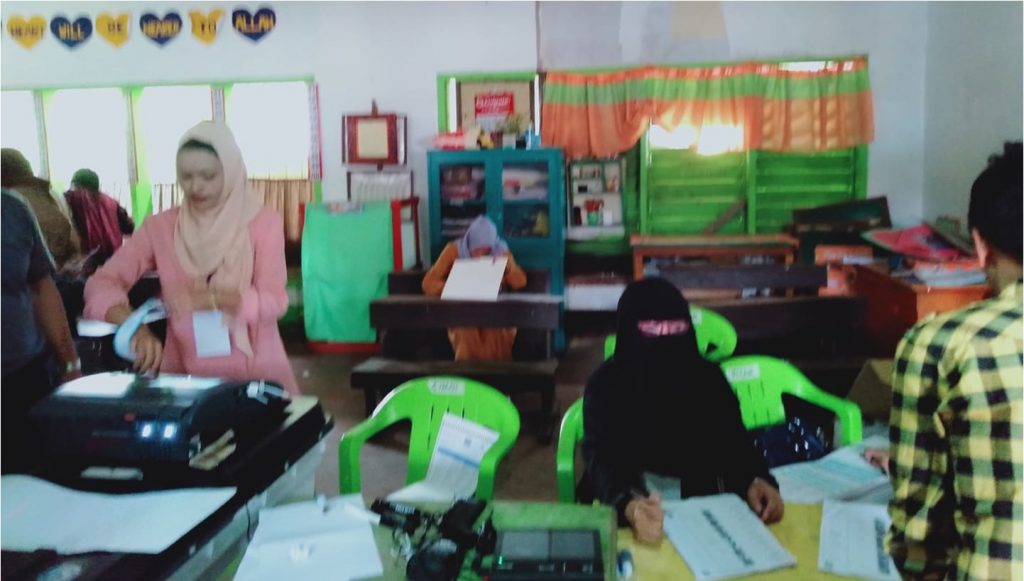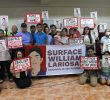
VRVM malfunction cause long queues in Dansalan, Marawi City in the May 2019 midterm polls. Image source: Legal Network for Truthful Elections, May 2019
The pilot test of the voter registration verification system was the second most expensive budget item in 2019 midterm elections. But the billion-peso project has now become a skeleton in the poll body’s closet.
It took the Commission on Elections (Comelec) over a year since the 2019 midterm elections to finalize its probe into the failed pilot testing of the voter registration verification system (VRVS), a project that cost Filipinos almost P1 billion.
Even now, the Comelec has kept mum about the blunder. In separate interviews, election watchdogs described the botched project as a “lost opportunity” that the poll body would rather forget.
“Tahimik ‘yan. Tahimik ang Comelec diyan,” Lito Averia, National Citizens’ Movement for Free Elections (Namfrel) National Council member, told the Philippine Center for Investigative Journalism (PCIJ).
“Binaon na nila sa limot ‘yan because it miserably failed. The mere mention of it, bawal,” said lawyer Rona Ann Caritos, executive director of the Legal Network for Truthful Elections (Lente).
Over the years, reports spread about poll clerks allowing voters to either cast more than one ballot or vote even if their registrations could not be validated. The VRVS project, had it been fully implemented, would have helped in preventing this by limiting human discretion in verifying voter registration.
VRVMs use a live fingerprint-scanning technology, eliminating the manual process of validating each voter in the voters’ list. This would have expedited voter verification in polling centers, a common choke point on Election Day.
It would have improved the integrity of the elections overall.
Voter verification is a standard feature of poll automation, which the Comelec is expected to pursue. But since the pilot test of the VRVS machines failed in 2019, the poll body was back to square one on the project and made no attempt to add the feature to the upcoming elections on May 9.
This blunder — among others in the last elections, such as the malfunctioning vote-counting machines, defective secure digital cards, and marking pens that bled on paper — prompted the Comelec to investigate.
On July 3, 2019, through Comelec Minute Resolution No. 19-0726, the en banc or full commission formed a fact-finding team to “conduct an in-depth investigation on the failure of VRVS.” It was composed of the poll body’s Steering Committee, Information Technology Department, Law Department, Personnel Department, and Procurement Management Department.
The “VRVS team,” as it would be called in later resolutions, found that 37% of the voter registration verification machines (VRVMs) could not be used by members of the Electoral Board (EB) due to procedural issues, while 14% were not used at all.
Fewer than half or 48% of the VRVMs were used during the 2019 elections.
No technician in 3 out of 5 precincts
The contract for the VRVS project was awarded to the joint venture between NextIX Inc. and Gemalto Philippines Inc. (now Thales Solutions).
Cebu-based NextIX is a family-owned company engaged in the business of researching and developing internet-based communication devices. It had won various contracts from government agencies, including the Department of Social Welfare and Development, Department of Trade and Industry, Philippine Institute of Volcanology and Seismology, and Philippine Postal Corp.. Meanwhile, Gemalto was an international digital security company. It was acquired by the Paris-headquartered Thales Group in 2019.
The VRVS contract provided for not only the lease of 32,067 machines but also training services and technical support for Comelec personnel and the EB.
Under the terms of reference (TOR), the joint venture shall provide “at least one qualified technician for every polling center” where the VRVM would be used on Election Day.
In polling centers with more than 10 VRVM units, “one technician for every 10 machines shall be provided. A lead technician shall be designated among them to be the overall technical supervisor for the polling center.” Exempted were polling centers in Caloocan City, Iloilo, Nueva Ecija, and Misamis Oriental, where technical support staff under the Department of Education Supervisor Officials (DESO) were put in charge.
But out of the other 21,158 precincts where the VRVMs were deployed, only 42% or 8,803 had a technician present, lawyer Francis Benedict Reotutar of Comelec’s Election and Barangay Affairs Department (EBAD) told PCIJ, quoting from the VRVS team’s internal investigation report.
Reotutar said the information was based on reports of poll clerks.
This meant that only two out of five clustered precincts had an attending technician to assist the EB, whose members were using the VRVMs for the first time.
Comelec Minute Resolution No. 20-0210 identified the reasons for the non-attendance of the technicians: unattended, wrong contact, invalid contact number, and no contact details. These were “clear violations of the TOR,” the resolution read.
Reotutar, who was the attorney-in-charge of the VRVS during the 2019 elections, also said that the joint venture submitted the credentials of only 6,824 technicians to the Comelec before the elections. Only 1,735 of them, or just a quarter, were deemed qualified for the position.
The TOR specified the following qualifications for the VRVM technician:
- at least a senior high school graduate;
- not over 40 years old;
- with information technology skills as certified by Comelec;
- physically fit and can work under pressure even on extended hours;
- has no derogatory record with the National Bureau of Investigation;
- able to speak, read, and write English or the local dialect where they will be assigned;
- not related within the fourth civil degree of consanguinity or affinity to any member of the same EB or to any candidate to be voted for or to the latter’s spouse; and
- has no pending case against him filed in Comelec or in court for any election offense.
In a memorandum dated March 5, 2020, Commissioner Marlon Casquejo, who headed the steering committee then, wrote that “the problem was not clerical but a technical blunder by reason of the service provider’s fault, which resulted in the impossibility of the service provider to deliver the service it promised.”
The VRVS team recommended that the performance security posted by the joint venture, which amounted to P49,357,316.10, be forfeited due to “violations” of the contract.
According to Reotutar, the following should also be deducted from the payment to the joint venture: forfeiture of the warranty security worth P44,069,059; liquidated damages totaling P10,641,44; and unpaid milestone payments, including the salaries of 3,776 VRVM technicians, amounting to P5,664,000.
The VRVS team recommended that the provider be blacklisted, said Reotutar.
However, the VRVS team said payment could still be released to the joint venture provided that “the goods and/or services delivered and rendered were accepted after inspection, all the documentary requirements are submitted, and all accounting and auditing requirements are met.”
Casquejo objected to the payment due to “the obvious violations of [NextIX-Gemalto] on the provisions of the TOR; proceeding with its payment will violate the provisions of the Procurement Law.”
The Comelec en banc, through Minute Resolution No. 20-0210, referred the matter to the Law Department “for further study and recommendation.”
The Comelec’s Law Department has not confirmed whether the recommendations were implemented. PCIJ sought clarification, but the office forwarded our request to EBAD. The EBAD had previously referred us to the Law Department, saying it was not privy to the resolution of the investigation.
PCIJ also reached out to the poll body’s Education and Information Department. Our request was forwarded to the Office of Commissioner Casquejo, who had also previously referred us to a different office.
PCIJ, via email and LinkedIn, also requested an interview with and sent questions to representatives of NextIX and Gemalto (now Thales Solutions) who were signatories in the bid documents and VRVS project contract, but we have not obtained any response as of the posting of this story.

The opening of bids for the Voter Registration Verification project is held on Sept. 26, 2018 at the Associated Marine Officers’ and Seamen’s Union of the Philippines Building in Intramuros, Manila. Image source: Legal Network for Truthful Elections, May 2019
P987 million down the drain
The VRVS project cost Filipino taxpayers P987,149,922. It was the second most expensive contract in the 2019 polls, next only to the P1.18-billion “Election Results Secure Transmission Solutions, Management and Related Services including Data Center Requirements” contract awarded to Smartmatic-TIM Corp.
In a letter to PCIJ, Casquejo said that the VRVS pilot was “neither a project of the Steering Committee, nor part of the automated elections process. Rather, it was the initiative of the Field Operations Group (FOG) of the 2019 [national and local elections].” Casquejo was head of the Steering Committee for the 2019 elections and the upcoming May 2022 elections.
The FOG was headed by deputy executive director for operations Teopisto Elnas Jr., according to Casquejo. Elnas was tagged by then senator Alan Peter Cayetano as one of “Garci’s boys” at the height of the “Hello, Garci” vote-rigging scandal involving former Comelec commissioner Virgilio Garcillano and then President Gloria Macapagal-Arroyo.
PCIJ sought an interview with Elnas but he declined and instead forwarded our request to the EBAD.
Good idea, bad implementation
William Yu, IT director of the Parish Pastoral Council for Responsible Voting (PPCRV), told PCIJ that the VRVS pilot was a “good opportunity” to use the biometric technology but there were “major kinks” in its implementation.
“An additional piece of technology is also an additional technical support complexity on the field,” Yu said. “But tech support must not be just ‘tech.’ It’s the ‘support’ part that’s more important because most of the problems we see with mature technologies like biometrics are procedural.”
Yu, who is also the chief technology officer at software companies Micro-D International and Novare Technologies, said there could have been some confusion on the expectations of Comelec from VRVM technicians.
“If I were a supplier, I would assume [the support is for] technical aspects only unless otherwise stated,” he said.
“In our business, for example, customer support is different from technical support, and [technical support is different] from user support or EB support,” he added. If that were the case, “the training and familiarity of EB” with the machines would not have been considered part of the scope of a technician’s support work, he said.
PCIJ scrutinized the project contract and TOR, and we found that “technical support” was not clearly defined in the documents. Only the “levels of technical support” to be provided by the joint venture were identified:
- First-level technical hotline operators, who shall handle reports received through telephone call, text message, email, or any other means of communication from the field technicians nationwide;
- Second-level technical staff, who shall consolidate all reports received and act on the reports that cannot be acted upon by the first-level hotline operators; and
- Third-level technical staff, who shall address all technical issues that cannot be solved by all levels of technical support.
But the lack of technicians on Election Day only compounded the problem of last-minute changes in the VRVS procedures.
EB support is “not a question of proficiency or familiarity with tech,” Yu said. “We have seen people who are not tech-savvy but can use the technology well. I think it’s comfort-level.”
“Wala na nga silang comfort level, [then you introduce] a new tech that they may not have a lot of experience with, or the training version might not be the same as the production version,” he said.
Last-minute changes
On May 8, 2019, or only five days before the casting of ballots, the Comelec en banc promulgated Resolution No. 10536, amending the general instructions for the VRVMs that was already the basis of the training of election officers two months prior.
The VRVMs initially required that the chairperson and a poll clerk log in their credentials to start up the system. But on April 25, 2019, the provider wrote the poll body about an error.
By then, the training of the EB members had ended, “so it’s possible that the poll clerks would not be aware of the changes,” Reotutar of EBAD said. Under the revised instructions, only the poll clerk was expected to log in and open the VRVM. Error in the log-in procedures would cause the machine to shut down and be “unusable,” Reotutar said.
From an IT perspective, Yu said major changes in instructions were “unusual” and would “definitely cause a lot of disruption.”
“When people get confused, if the system does not work the way they’re expecting it to, then they can just say, ‘Oh, it’s not working, then I’ll not use you,’” he said. This was also reflected in the monitoring reports of Lente and Namfrel on the 2019 elections.
Yu explained that even if system adjustments were necessary, the procedures should be the same as much as possible. A main consideration was whether the bug occurred only at certain times.
“For example, if it only fails to register the EB if the EB has an ‘Ñ’ in their name, then you can say, ‘Let’s not fix it and just tell the EB to put ‘N’ instead,” Yu said. “That’s easier and it can sufficiently solve the problem.”
“If it affects only certain people, can you [do] a workaround? Is the workaround better than the fix? With a fix, you have to tell everybody. If it’s a workaround, then it’s only those people who are affected,” he said.
So, what particular error triggered the adjustment in the VRVM system and procedures? Neither Comelec nor any of the companies in the joint venture has so far responded to PCIJ’s queries on the matter.

In Kilala Elementary School in Marawi, a voter registration verification machine stops working at 10 a.m. on Election Day in May 2019. Image source: Legal Network for Truthful Elections, May 2019
‘Too new, too quickly’
The project also had several “points of failure,” according to election monitors.
A common critique was the designation of pilot areas across the country that were equivalent to a third of a nationwide implementation. Then Comelec commissioner Luie Tito Guia said the number of units to be used for a pilot test was too many.
“A pilot test can result in a decision, either to adopt what is being tested or reject it. If the decision is to reject it, over a billion peso[s] for a pilot test is definitely high,” Guia wrote in his position on Minute Resolution No. 18-0546, which allowed the increase of the approved budget contract for the VRVS project. “It may make better sense to reduce the number of units to be purchased if our concept is merely to pilot the project.”
A positive side to such an ambitious pilot project is that if it succeeded, it would have been easier to implement in the following polls, Yu said. “However, the risk is you have to get a third of the country’s precincts to work.”
A smaller area, where all the support could be consolidated, would have been better, he said.
Another issue raised was the accuracy of the poll body’s biometrics registry.
Namfrel’s Averia pointed to instances when the VRVMs failed to match voters’ identities.
“What makes it complicated is the fingerprint reader. Baka hindi nagma-match ang kanilang standard on that fingerprint reader with the data that is stored in the database ng Comelec,” he said. “So, marami ring points of failure ‘yan.”
“Hindi ko lang maintindihan bakit masyadong minadali ‘yung project. Parang masyadong minadali ‘yung project in time for the 2019 elections,” he said.
Yu agreed. “More could have been done for training. They could have tested the data a little better because… when we implement a verification portion, you cannot ask for more minutiae than what was collected.”
“We felt it was too new too quickly,” Yu said. “Maybe it would have been better if we didn’t try to boil the ocean.”

Members of the Electoral Board opt to use the voters’ list instead of the voter registration verification machines. Image source: Legal Network for Truthful Elections, May 2019
Option to purchase not exercised
Due to the massive failure of the VRVS pilot, it’s unclear whether the Comelec would use the same or a similar verification system in the next polls. What’s sure, though, is that the poll body did not exercise its option to purchase the machines at no cost.
Comelec Minute Resolution No. 19-0726 showed that the poll body, through then executive director Jose Tolentino Jr., looked into the possibility of “upgrading” VRVMs and “[using] the VRVS in registration” for the 2020 Barangay and Sangguniang Kabataan Elections.
The TOR required “customizable functionalities” in the VRVS, which included the “switching of application from voter verification to capturing of data of applications’ information for registration.”
However, upon review, Comelec information technology director Jeannie Flororita found that even if the option to purchase was exercised, the joint venture “cannot complete the full registration system in time for the training of the election officers.”
Flororita also raised technical issues such as the “difficulty of using the VRVM screen for encoding purposes” and “as a signature pad using the finger.”
Following preliminary negotiations with the joint venture, the Comelec en banc, through Minute Resolution No. 20-0413, agreed that there was “no basis for the exercise [of the option to purchase] thereof… and in the absence of a valid consideration, there can be no perfected option contract to speak of applying the law.”
The VRVS project was expected to weed out flying voters, or those who try to vote either in more than one precinct or by using the name of another voter.
Comelec’s Reotutar said it could also be used as proof of election offense because “it shows an alert that a person has already voted… which can facilitate prosecution.”
Lente’s Caritos also pointed out that the verification project was “meant for efficiency” and to help address a choke point on Election Day, when the poll clerk would verify the identity of a voter using the voters’ list..
“At the same time, [it improves] the integrity of the elections,” Caritos said. “In some controlled areas, some members of the EB would allow some people to cast their ballots even if their identities as voters had not been validated.”
“Makakatulong siya sa integrity kasi wala nang human discretion,” she said.
It was also for this reason that Guia, now a retired commissioner, said the poll body should have exercised the option to purchase.
“If it were up to me, I will just scale it at low cost and probably use it because there’s a strong demand for that to be implemented especially in the South,” Guia told PCIJ. “Itong VRVM, palagay ko magagamit pa ‘yan e… dapat binili siguro.”
PPCRV’s Yu offered a different perspective.
“The worst thing that could happen is you exercise an option to purchase something that you will not use… Even though zero cost ‘yung exercise, you’re going to warehouse that. And in the next election, you’re going to refurbish that and you’re going to hire project management, technical support,” he said.
But election monitors and watchdogs all agreed that the VRVS was a “lost opportunity.”
“It would’ve been an important feature [in the elections],” Averia said.
“The problem is that it left a bad taste in people’s mouth, so nobody wants to try it again,” Yu said. “But the technology was actually good, so sayang. Nasasayangan kami.” –PCIJ, May 2022










